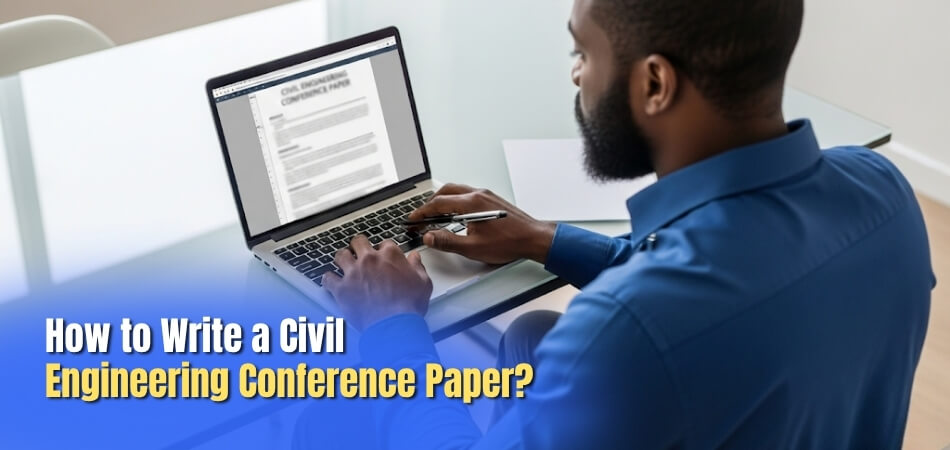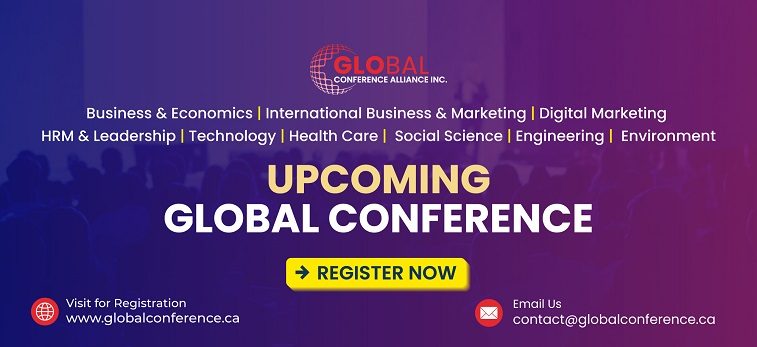These days, civil engineering conferences are a key way to share valuable ideas and real project work. One important part of these events is the conference paper, which explains your research clearly and simply. If you’re new to this event, you might be thinking, How to write a civil engineering conference paper?
Writing a civil engineering conference paper follows a simple structure. It starts with understanding the topic and conference rules. Then, write a clear abstract, introduction, method, results, and conclusion. Include charts or tables to explain your findings. Always list your sources and review your paper carefully before submitting.
Want to know how to make your paper stand out and meet conference standards? Keep reading to find all the important steps and tips you need to write an effective civil engineering conference paper. This article covers everything you should know.
How to Write a Civil Engineering Conference Paper?
Writing a paper for a civil engineering conference may seem difficult at first, but it gets a lot easier if you follow a simple procedure. Most papers follow a common format, and sticking to that will put you well on your way. Let’s go over each section and discover the proper approach to complete it.
Understand the Topic
Civil engineering conferences usually focus on topics like structural engineering, transportation, the environment, or soil studies. Before you begin writing, make sure you understand the main theme and rules of the conference. If you’re planning to submit to upcoming conferences in USA or other countries, it’s important to read their guidelines carefully so you know what they expect.
Craft a Brief Abstract
The abstract is a concise overview of your research. It should summarize the civil engineering problem you tackled, your methodology, the key findings, and the implications of those results. Keep it brief—around 150 to 250 words—and avoid lengthy background explanations, focusing on the core message.
Write a Clear Introduction
Begin by stating the civil engineering issue your work addresses and why it’s important. Provide enough background for readers to follow the context, including previous research or practical challenges. Then highlight what sets your work apart or how it advances the field. This prepares readers for the details ahead.
Detail Your Methodology
Explain how you conducted your study. This could include lab tests, fieldwork, software simulations, or analytical techniques relevant to civil engineering. Present your process clearly and systematically, making it easy for others to understand and potentially replicate your approach. Include sufficient detail but keep it concise.
Present Your Results
Share the findings of your research, using visuals like charts, tables, or graphs to clarify your points. Introduce each figure before showing it so readers understand what they’re looking at. Focus on the major outcomes that highlight your study’s significance without getting lost in every small detail.
Interpret the Results
Discuss what the results mean for the civil engineering community. Did they confirm your hypotheses or reveal unexpected trends? Were there any limitations or challenges? Explain how your findings contribute to solving engineering problems or enhancing knowledge in the field.
Conclude Strongly
Summarize your key conclusions and their relevance clearly and confidently. Suggest how others might build on your work or apply it practically. Don’t just repeat everything from before—summarize the key parts. End your paper in a clear and confident tone. A strong finish creates a lasting impression.
Cite Your References
List all sources you used, including technical papers, standards, books, or websites. Use the citation format required by the conference, such as IEEE or APA style. Proper referencing demonstrates thorough research and respect for prior work.
Final Review
Before submitting, read your paper out loud to catch mistakes and awkward phrasing. Double-check that the formatting—font, spacing, and page size—matches the conference’s rules. Attention to these details helps make your paper look polished and professional.
What Are the Benefits of Writing a Paper for a Civil Engineering Conference?
There are a lot of advantages to writing a paper for a civil engineering conference that go beyond simply sharing your work. It can help you grow in different ways and open up new chances. If you want to know what makes it so useful, keep reading to find the key advantages of writing a conference paper.
Skill Improvement
Writing a paper helps you get better at explaining your ideas clearly. You learn how to organize your thoughts and present them step by step. It also improves your writing and research skills, which are useful in many areas. This practice can make you more confident when sharing your work.
Building Knowledge
When you write a paper, you dive deep into a specific topic. This process helps you learn more than you would by just reading or listening. You become more familiar with the latest studies and developments in civil engineering. It also pushes you to think carefully about your work.
Sharing Ideas
A conference paper lets you share your ideas with others who care about the same subjects. It gives you a chance to explain your discoveries and how they can help solve real problems. By sharing, you contribute to the growth of knowledge in civil engineering. This can inspire others as well.
Getting Feedback
Presenting your paper at a conference means experts and peers will read it and may give you helpful feedback. This feedback can show you what is strong and what might need improvement. It’s a chance to learn from others and make your work better. Constructive comments help you grow.
Networking Opportunities
Although it’s about writing, the process also connects you with people in your field. You meet others who share your interests and can exchange ideas. These connections might help you in future projects or collaborations. It’s a great way to find new friends and mentors.
Recognition and Credibility
Having a paper accepted at a conference shows that your work is valuable. It gives you recognition among professionals and researchers. This can boost your confidence and add to your reputation. Being known for your research can open many doors.
Career Growth
Writing and presenting papers can help in your career by showing your dedication and knowledge. It demonstrates that you can handle complex topics and communicate them well. This experience can be important for future job opportunities or higher studies. It adds to your professional profile.
Personal Satisfaction
Completing a paper and seeing it published or presented gives a sense of achievement. It feels good to know that your work matters and can make a difference. This satisfaction can motivate you to take on new challenges and keep learning.
Formatting and Style Guidelines Often Required When Crafting a Civil Engineering Conference Paper
Formatting and style are important when writing a civil engineering conference paper, but many people don’t know exactly what to follow. These rules help make your paper clear and professional. Keep reading to learn more about the key formatting and style tips you should follow.
Paper Length
Most conferences want papers to be a certain length, usually between 5 to 10 pages. This helps keep the writing focused and not too long or too short. If the paper is too short, it may seem incomplete. If it’s too long, it might be hard for people to read it all. Always check the page or word limit given by the conference. Try your best to stay within that limit.
Font and Size
Using the right font makes your paper look clean and easy to read. Most conferences ask for simple fonts like Times New Roman or Arial. The usual size is 10 or 12 points, depending on what the rules say. Don’t use fancy fonts, as they can be hard to read. Also, try not to change font styles too much in the same paper. Keep everything the same from start to finish.
Page Setup
Your paper must be written on a page of the correct size, like A4 or letter size. Margins are usually 1 inch on all four sides of the page. Some conferences ask for single spacing, while others may ask for 1.5 line spacing. It’s best to check before you begin writing. Following the correct setup makes your paper look well-organized. A good layout is just as important as good content.
Heading Styles
Headings help break your paper into sections so readers can follow along easily. Use bold or a slightly bigger font for main headings. Subheadings can be a little smaller, but they should still stand out from the rest of the text. Keep all headings the same style throughout the paper. Don’t change the format halfway through. This helps keep your paper clean and easy to read.
Citations and References
If you use any books, websites, or research papers, you must give credit. This is called a citation. Many conferences ask for a special format like APA or IEEE. Make sure to use the same style all the way through your paper. Also, list all your sources at the end of the paper under “References.” Giving credit shows that your work is honest and well-researched.
Figures and Tables
Charts, graphs, and tables can help explain your results clearly. Make sure to label each one with a number and a short title. Put them close to where you talk about them in the text. Don’t forget to explain what each figure or table shows. If needed, add a small note below the image. This makes it easier for readers to understand your data.
File Format
Before you send your paper, check what file type the conference wants. Most of the time, they ask for a PDF file because it keeps the layout the same. Sometimes they may also accept Word documents. It’s a good idea to save your paper in both formats, just in case. Always double-check the file name and format before submitting. Following this step can help avoid problems later.
Is It Challenging to Choose a Relevant Topic for a Civil Engineering Conference Paper?
Yes, it can be a little hard to choose a good topic for a civil engineering conference paper. There are so many ideas, and it’s easy to feel confused. You might not know where to begin or what topics are important. Choosing the right one takes some thinking and simple research. Let’s see how to pick a topic that fits your paper well.
Know the Field
First, it’s good to know the different areas in civil engineering. This includes things like roads, buildings, bridges, water systems, and more. When you know the parts of the field, you can find what interests you the most. It also helps you understand what kind of problems are common. This makes it easier to think of topics to work on.
Check Real Problems
One way to find a topic is by looking at problems in the real world. For example, you might notice how roads get damaged during the rainy season. Or how old bridges need better repairs. These real-life issues can turn into great paper topics. Solving something real makes your paper more useful.
Look at Past Papers
Reading papers from earlier conferences can give you some smart ideas. You can see what topics were liked and how they were written. This helps you avoid choosing the same ideas again and again. It also shows what kind of topics are too common or outdated. This way, you can bring a fresh idea.
Think About Your Interest
It’s always better to pick a topic that you find fun or exciting. When you enjoy the topic, you won’t get bored while working on it. It also helps you explain things better because you truly care about the subject. You don’t have to pick something too big—just something you find cool. Even simple topics work great if explained clearly.
Keep It Simple
Try not to choose a topic that is too big or too hard to explain. A small, clear topic can be more powerful than a wide, confusing one. For example, instead of writing about “All Kinds of Bridges,” you can write about “How Small Bridges Handle Rainwater.” Simple ideas are easier to write about and understand. Plus, they save time.
Ask Others
Sometimes talking to a teacher, friend, or expert can help a lot. They might suggest new ideas or guide you if you’re unsure. They might even help you find a topic for a civil engineering conference paper that fits well with your interests and the conference theme. It’s okay to ask questions and get advice. You don’t have to come up with everything on your own. A short chat can give you a clear direction.
Follow the Theme
Many conferences have a theme, which is the main topic they are focusing on that year. Before picking your topic, check if the conference has one. If your topic matches the theme, it has a better chance of getting picked. It also shows that you’ve paid attention to what the event is about. Always read the guidelines first.
Check What’s New
Try to choose a topic that connects with new tools, materials, or methods. This shows you are thinking about the future of civil engineering. New ideas are often more interesting and stand out from old ones. Even if it’s something small, if it’s fresh, it grabs attention. Just make sure it’s still easy to understand and explain.
How to Align Your Paper With Conference Guidelines and Themes?
When you write a paper for a civil engineering conference, it’s not just about having a good topic. You also need to make sure your paper matches what the event is asking for. Let’s go over how to do that.
Read the Guidelines
Every conference gives a set of rules for paper submissions. These rules might include page limits, font size, and file format. Reading these carefully helps you know what’s allowed and what’s not. If you skip this part, your paper might get rejected even before it’s read. So always go through the rules first.
Understand the Theme
Most conferences have a theme, which means a main topic they are focusing on. For example, it could be about eco-friendly buildings or smart roads. Try to make your paper fit with this theme. When your work matches the theme, it shows you’ve paid attention. This also makes your paper more likely to get noticed.
Match the Topic
Once you know the theme, pick a topic that clearly connects to it. Don’t choose something that feels far off or unrelated. Even a small topic can work well if it fits the main idea of the event. Think about how your topic can solve a problem or bring something new. Keep it simple but clear.
Use the Right Format
Follow the layout that the conference asks for. This means putting sections like abstract, introduction, and conclusion in the right order. Also, check if they want headings in bold or how they want your references listed. Using the wrong format can make your paper look messy. Always double-check the format before you submit.
Follow Word Limits
Conferences usually have word limits for each section of the paper. For example, the abstract might need to be under 250 words. Going over the limit can lead to rejection. Try to say more with fewer words by keeping your writing simple. Cut out any extra words that don’t help explain your point.
Include Keywords
Some papers ask for keywords under the abstract. These are words that show what your paper is about. Use words that match the theme and topic well. This helps readers find your paper easily if they’re looking for similar topics. Keep the keywords short and relevant.
Check Before Sending
Before sending your paper, take a moment to review everything. Make sure the format is right, the topic matches the theme, and nothing is missing. Ask someone else to read it if you can. A quick review can help catch small mistakes. Once it looks good, then go ahead and submit it.
Steps You Can Take to Review Your Civil Engineering Conference Paper Before Submission
Before you send your civil engineering conference paper, it’s important to check it carefully. A small mistake can make your paper look weak, even if your idea is good. Taking time to review helps you fix problems and improve your writing. Let’s look at some easy steps that can help make your paper better before you send it.
Step 1: Read It Out Loud
Reading your paper out loud helps you hear if something sounds strange or too long. You can catch missing words or sentences that don’t make sense. If a sentence sounds confusing, try to make it shorter or simpler. When you read with your voice, your brain pays more attention. You can also notice if your ideas flow well from one part to the next. This step is simple but very helpful.
Step 2: Check the Structure
Your paper should have a clear structure, like a beginning, middle, and end. The main parts are usually the introduction, method, results, and conclusion. Make sure each part is in the right place and nothing is missing. If something feels out of order, move it around to make it smoother. Each paragraph should talk about only one main idea. When your paper is well-organized, it’s easier for people to understand.
Step 3: Look for Errors
Check your paper for spelling and grammar mistakes. Even one small error can make your paper look messy. Fix words that are spelled wrong and make sure your sentences are complete. Also, check that your punctuation marks are in the right places. Try to use simple and clear words. Reading slowly helps you find mistakes you might miss when reading fast.
Step 4: Review the Diagrams
If your paper has diagrams, tables, or charts, make sure they are clear and useful. Each one should have a short title and be explained in your writing. Don’t use images just to make the paper look full—only add them if they help explain your point. Make sure everything is easy to read and not blurry. Put the diagrams in the right place in your paper, close to where you talk about them. A good diagram can make your paper more interesting.
Step 5: Match the Format
Follow the rules given by the conference for how the paper should look. This includes things like font size, line spacing, and where to put your name. Check if your paper has the right number of pages and follows the layout they ask for. If you don’t follow the format, your paper may not be accepted. You can look at a sample paper to see how it should be done. Always double-check before sending it.
Step 6: Get Another Opinion
Ask someone else to read your paper, like a friend or someone who understands the topic. They might find mistakes that you didn’t notice. They can also tell you if something is hard to understand or unclear. Their suggestions can play a big part in enhancing civil engineering research paper before it’s finally submitted. Listen to what they say and make changes if needed. You don’t have to follow every idea, but a second opinion always helps.
Step 7: Take a Short Break
After writing your paper, take a break before reviewing it. Resting helps you return with a fresh mind and spot mistakes more easily. Even a 20-minute break can make a big difference. When you feel fresh, your brain works better and you can think more clearly. Don’t wait until the last minute to check your paper. Give yourself enough time to read, fix, and feel confident before sending it.
What to Expect After Submitting Your Civil Engineering Conference Paper?
After you send your civil engineering conference paper, there are still a few things that can happen. It’s not just about hitting the send button and forgetting it. The next steps are also very important and worth knowing. Here is what usually happens after your paper is submitted:
Confirmation Email
Right after you submit your paper, you will usually get a confirmation email. This message lets you know that your paper was received. If you don’t get one, check your spam folder or ask the organizers. Keep this email safe in case you need it later. It often has your paper ID and other useful details.
Review Process
Once your paper is submitted, experts will read and check it. They look at how well it is written, if the topic is good, and if it matches the theme. This process takes some time, so you may need to wait a few weeks. They might also look at your spelling, structure, and diagrams. It’s important to be patient during this step.
Possible Revisions
Sometimes the reviewers will ask you to make changes. They will send comments or notes telling you what to fix. These changes could be small or big, like fixing a sentence or adding more detail. You’ll usually get a deadline to send the new version. Doing the changes carefully helps your paper get accepted.
Acceptance Notification
After the review, you will get a message saying whether your paper was accepted or not. If it’s accepted, that means it will be part of the conference. This is great news and means your hard work paid off. If it’s not accepted, don’t feel bad—many people try again and do better next time. Reading the reviewer notes can help you improve.
Conference Preparation
If your paper is accepted, you’ll need to prepare for the conference. This might include making a slide presentation or getting ready to speak about your topic. You might also need to register for the event. Some conferences are in person, and some are online. It’s good to know what is expected early on.
Final Paper Submission
Some conferences ask for a final version of your paper after the changes. This version must be perfect and match the format they ask for. It’s your last chance to check for mistakes. Make sure the diagrams, headings, and spelling are all correct. Once this is done, your paper is all set.
Publishing and Sharing
After the conference, your paper might be published in the conference book or on a website. This means other people can read and learn from your work. It feels great to know your paper is being shared. You can also use this paper to show others what you’ve done. It becomes a real part of your work.
Frequently Asked Questions
Writing a conference paper can feel confusing at first, so it’s normal to have questions. Here are some of the most common questions people have when preparing their civil engineering conference paper, along with easy answers to help you get started.
What Makes a Civil Engineering Conference Paper Different From a Journal Paper?
A civil engineering conference paper is usually shorter and more focused than a journal paper. It is written for a specific event and audience, often to present work in progress or fresh ideas. Journal papers are more detailed, often reviewed more deeply, and meant for long-term record. Conference papers aim to spark discussion and are often shared live.
How Can I Make My Civil Engineering Conference Paper More Interesting to Read?
To make your civil engineering conference paper more interesting, use clear words and short sentences. Add real examples or simple charts. Make sure each part connects well with the next. When the paper is easy to understand, more people enjoy reading it.
Should I Include Case Studies in a Civil Engineering Conference Paper?
Yes, adding case studies in your civil engineering conference paper can help explain your idea better. Case studies show how your work was used in real situations. They also help readers see the results of your project. This makes your paper more helpful and stronger.
How Do I Write a Good Title for My Civil Engineering Conference Paper?
A good title for your civil engineering conference paper should be short and clear. It should explain your topic in simple words. Avoid long or confusing phrases. A smart and simple title helps others know what your paper is about right away.
Can I Add Personal Experiences to My Civil Engineering Conference Paper?
Yes, personal experiences can be a great part of your civil engineering conference paper if they match the topic. They help make your paper feel real and easy to connect with. Just be sure they are clear and useful for explaining your point. Keep them short and focused.
How Can I Stay Focused While Writing a Civil Engineering Conference Paper?
To stay focused while writing your civil engineering conference paper, set small goals for each section. Take short breaks and keep your work area free from distractions. Writing a little every day can help you stay calm and finish on time. Planning makes it easier to stay on track.
Should I Add a Problem Statement in My Civil Engineering Conference Paper?
Yes, adding a problem statement in your civil engineering conference paper is a smart idea. It shows what issue you are solving and why it matters. Keep it short and clear. It helps readers understand your work right from the beginning.
How Do I Handle Too Much Information in My Civil Engineering Conference Paper?
If you have too much to include in your civil engineering conference paper, pick only the most important parts. Use clear visuals to explain more in less space. Cut out any extra words or ideas that don’t add value. Keeping it simple helps readers stay interested.
Conclusion
Finishing your first civil engineering conference paper is a big step and something to feel proud of. It may seem tough at first, but with the right steps, you can share your work and ideas with the world. Remember, every paper is a chance to learn and grow.
If you’re still wondering how to write a civil engineering conference paper, just take it section by section and keep things clear and simple. Follow the guidelines, use real examples, and don’t be afraid to ask for feedback from others. Every bit of effort you put in makes your paper stronger.
So go ahead—start planning, writing, and sharing your story. Your research can inspire new ideas, solve problems, and make a real difference. With each step, you’ll get better at writing a civil engineering conference paper and become part of a community that builds the future.








